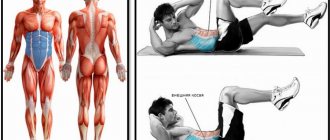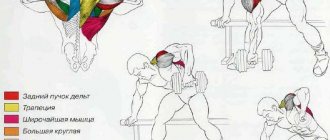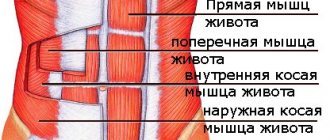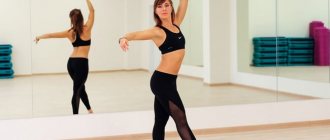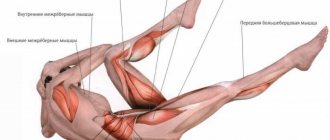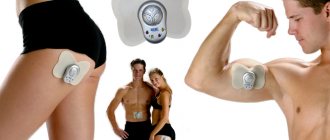- August 21, 2018
- Home workouts
- Timoshenko Mikhail
The abdominal region is a part of the body that needs constant development. After all, this is where the most impressive reserves of subcutaneous fat are concentrated. Especially when it comes to women. How to get a beautiful tummy? What needs to be done to properly pump up weak abs? We will look at photos and detailed descriptions of training in our article.
Briefly about the structure of the abdominal muscles
What muscles work when pumping the press? In the course of applying loads to the presented area, the so-called core muscles are involved. These structures form the abdominal corset, holding the internal organs and stabilizing the position of the body. Regardless of a person’s gender, the abdominal muscles include the rectus abdominis, oblique and transverse abdominis muscles. It is the rectus abdominis muscle that forms those same cubes and is most noticeably pumped during active training. However, without training the oblique and transverse muscles, posture may suffer and problems with maintaining balance may arise.
How to determine diastasis recti
A simple test that involves measuring the distance between the inner edges of the rectus abdominis muscles will help determine the presence of diastasis at home. Lying on your back on a hard surface, bend your knees. One hand is placed under the head, the other on the line above the navel. In a relaxed state, the chest is lifted off the floor, and the fingertips are immersed in the stomach. The size of the dip allows you to determine the severity of diastasis of the rectus abdominis muscles. It is more noticeable between the navel and the xiphoid process of the sternum. Doctors use a similar option for diagnosing diastasis; instrumental and hardware examinations are prescribed if the patient is obese, has a suspected hernia, or prolapsed organs.
Diastasis of the rectus muscles is accompanied by a number of characteristic signs, so it is easy for a doctor to determine the diagnosis. The main methods for confirming diastasis are examination and palpation of the inner edges of the rectus abdominis muscles. The patient is asked to do the following:
- lie on your back on a hard couch;
- bend your knees, rest your feet completely on the surface;
- tighten your abdominal muscles.
The doctor feels the protruding ridges along the edges of the abdominal muscles and measures the amount of their divergence with a ruler.
Measuring the width of the discrepancy helps to clarify the degree of diastasis. The initial stage is characterized by a slight expansion in the navel area, the deviation does not exceed 5 cm. The changes practically do not affect the shape of the abdomen. With stage 2 pathology, the defect increases to 7-8 cm. The abdominal cavity begins to bulge from below. A white line width of more than 8-10 cm indicates a severe form of diastasis of the rectus muscles. The abdomen becomes saggy, and there is a high probability of developing an umbilical hernia.
A pronounced diastasis is noticeable in a standing position in the form of a vertical defect between the rectus abdominis muscles. If a person is asked to tense his abdominals, a longitudinal keel-shaped protrusion is noted.
This method of diagnosing diastasis is ineffective if the patient is overweight; the doctor prescribes an ultrasound. Sonography visualizes the thinning of the abdominal line, clarifies the amount of stretching, determines the presence of a hernia, prolapse of internal organs. In rare cases, radiography is performed. Based on the CT results, the condition of the abdominal cavity is assessed and diastasis of the rectus abdominis muscles is differentiated from pathologies that have a similar clinical picture.
The patient's main complaint in the initial stage is protrusion of the abdomen in the area of the white line. Men note a lack of definition during constant training to work their abdominal muscles. Internal organs are not affected by diastasis, so the stomach will hurt only in severe cases, accompanied by complications. In stage 3, people often complain of the following symptoms:
- dyspepsia (nausea, bloating, constipation);
- feeling of heaviness in the legs when walking;
- muscle atrophy in the problem area;
- lumbopelvic pain.
When the rectus abdominis muscles diverge during pregnancy, girls notice the defect in the postpartum period. They often complain of urinary incontinence when coughing or sneezing.
Suspicion of the development of diastasis in young athletes arises when MARSS syndrome, flat feet with valgus deformity, and frequent ankle subluxations are detected.
Where and how often to exercise to strengthen weak abs?
The most comfortable place to pump up your abdominal muscles is your own apartment. The main thing is to have a gymnastic mat available. It is better to train in the middle of a spacious room, so that surrounding objects do not interfere with active body movements. It will be beneficial to use a large mirror, which will allow you to monitor the correct execution of the exercises and note inaccuracies.
Now let's talk about the frequency of classes. If weak abdominal muscles do not support your stomach, it is recommended to train at least 4-5 times a week. First, various bends of the body are performed to stretch and warm up the abdominal muscles. Then more serious loads are placed on the weakly inflated press. During each repetition you need to do 10 repetitions of movements. If you lack the strength to perform the exercises correctly, you should start with fewer repetitions.
The most common mistakes when doing abdominal exercises
Check yourself - these shortcomings can reduce all your efforts in class to a minimum.
- Low-repetition work with weights. “The press, like any muscle, grows, and it grows forward - that is, in thickness, so you shouldn’t get carried away with weights when working on the press, it loves quantity,” says Evgeniy Shatlovsky.
- Working out the oblique abdominal muscles by bending over. It’s not that this is ineffective - the muscles become toned from such movements. However, growing muscles will increase your waist circumference.
- Improper execution of exercises. For example, working the thigh muscles when doing crunches while sitting. <<Twisting can be performed with active movement in the hip joints and leg muscles, but if you do this using the spine (and not the hip joint), then the load on the abs will be very good, explains Ruslan Panov. — When our legs are “disabled,” then the load goes on the abs, as the only muscle that adducts the spine. If we do this due to tension in the hips and iliopsoas muscles, then the abs are not pumped >>.
Seated crunches
People who have truly weak abdominal muscles should start moving towards progress with the simplest exercise. We are talking about twisting the body in a sitting position. You can train on the floor or on a chair.
So what should you do? In a sitting position, hands are placed behind the head. Take a deep breath into full lungs. As you exhale, the body smoothly turns to the side with tension in the abdominal muscles. The starting position is accepted. A turn is made in the other direction.
Despite the low complexity of the exercise, a noticeable effect can be obtained already after the first month. The muscles of the abdominal area will become toned, which will allow you to move on to more fruitful workouts.
Most common mistakes
In pursuit of the dream abs, we make mistakes. Sometimes very stupid. And in order to achieve your assigned sports goals, you should perform the exercises correctly. Otherwise, the exercises will not bring any benefit, and in the worst case scenario, they can even cripple you.
What is better not to do during training:
- When twisting, do not lift your torso completely. This mistake once again strains the back muscles and disrupts the functioning of the chest. It would be correct to raise the body halfway.
- Abdominal workouts daily. The body needs time to recuperate. By resting your muscles, you help your body. Thus, you will see results much faster if you focus on training different muscle groups on certain days.
- Doing the plank exercise for too long. If your abdominal muscles are strong, then a few minutes in a horizontal position is not a problem for you. For greater efficiency, it is worth not increasing the time, but removing one of the support points, for example, raising an arm or leg.
- Perform exercises purely on the abs. The body does not know how to lose weight locally. Therefore, in pursuit of the coveted six pack, doing crunches, lifts, planks, scissors, etc., do not forget about other muscles. Fat will not go away if you repeat the same physical activities. Cardio exercises are great for defining your abdominal muscles, as they quickly burn fat and excess calories.
- Change your exercise routine. This point is very similar to the previous one. However, the point is that you can not change your activities radically, but by adding elements of other types of physical activity. For example, yoga, Pilates, and stretching will be useful. With such a variety of training, muscles will become stronger more effectively.
- Abdominal workouts are hard work. During training, the stomach should always be in a tense state. Watch this moment carefully. Since muscle memory will be trained during execution and, accordingly, the stomach will come into the desired shape.
- A balloon that is not fully inflated. If you additionally use equipment for physical exercise, then there are also certain requirements for it. The ball should be slightly deflated so it will not injure your back muscles. To check if it suits you, lie down on it. The right ball will allow you to lie flat without arching.
- Train your back muscles. This is necessary not only for professional athletes. This is required so that there is no imbalance in the muscles that support the spine. Engage your abdominal girdle fully.
- Don't put your hands behind your head. Many people think that this position provides maximum support. But in fact, this is how you bring yourself closer to a neck injury. It will be better if you place your hands crosswise on your chest.
- Do not lift your legs from a lying position. For this exercise, use a special simulator. It will provide additional support for the lower back and focus tension on the desired muscles.
- Don't arch your back when doing the plank. This exercise requires a straight line. The spine should be straight without bending. When arching your butt upward, the exercise is useless for the abdominal muscles.
In general, any physical exercise is best performed under the supervision of experienced trainers. It is a qualified specialist who can advise and point in the right direction.
Plank
The plank exercise allows you to perfectly pump up weak abs and start the process of active fat burning. Despite its static nature, training requires significant effort and the ability to maintain balance. The exercise is performed according to the following scheme:
- The emphasis is placed on the elbows face down.
- The legs straighten and hold the body on the balls of the feet.
- The back is in a level position.
- The abdominal muscles are tensed as much as possible and maintained in this state for 30 seconds.
- During one workout, 3-4 approaches are performed.
Mill
A good solution for training weak abs is the mill exercise. In the starting position, the body is in a straightened position on the back. The legs bend at the knees and rest the feet on the floor. Hands are placed behind the back of the head. The left knee is raised. At the same time, the head rises from the floor. The right elbow reaches towards the knee. The starting position is accepted. Then the body movements are repeated with a change of arms and legs. To strengthen weak abdominal muscles, it is enough to perform 4 sets of 10 repetitions with training intervals every other day.
Exercises for mom and baby
And here is a set of exercises that form a flat stomach, which you can perform together with your child. At the same time, the classes will benefit both the mother and the baby, who will be next to the mother.
- Diaphragmatic breathing. The mother lies on her back, the baby lies on her mother’s stomach, facing her. As you inhale, inflate your stomach, as you exhale, draw in the abdominal wall, hold your breath, hold your stomach in for several seconds. Repeat 10 times. The benefit of this exercise for the baby is that lying on his stomach prevents colic; the baby also learns to hold his head up and sit up.
- Mom stands on all fours, the baby lies on his back near her arms. As you inhale, bend at the waist and raise your head, while exhaling, arch your back, simultaneously lowering your head and tensing your abdominal muscles. Repeat 5-10 times. At the same time, the baby learns to follow the mother’s movements and turn his head.
- Mom stands on all fours, the baby lies on his back near her arms. Perform side squats: sit to the right, then to the left of the buttocks - twisting, sit on the right buttock, return to the starting position, then sit on the left buttock. Repeat 10 times.
A diet without exercise will lead to weight loss, but it will not give you a flat stomach.
The following exercises are for women with good physical fitness and coordination:
- The mother lies on her back, her legs bent at the knees, raised above the floor, her shins parallel to the floor, the baby lies on her tummy on her legs (on her shins) facing her. The child must be held by the back or by the arms. Keeping your shins parallel to the floor and raising your head and shoulders, reach with your right hand to the left half of the baby’s back, then with your left hand to his right side. Repeat 10 times.
- Starting position - as in the previous exercise. Straighten your legs first one at a time, then simultaneously. Repeat 10 times for each movement.
- Mom stands with her feet shoulder-width apart. Lean in the opposite direction from the baby. Repeat 5-10 times in each direction. You can take the baby in your arms.
Bike
Weak abs can be thoroughly worked out by doing an exercise that simulates pedaling a bicycle. In this case, the leg muscles are also involved.
First, assume a position lying on your back. The legs are slightly raised and the knees are bent at a right angle. Hands are located on the sides of the body. Rotations are performed with the lower limbs. Tension is concentrated in the abdominal area. About 20 repetitions are performed. After several approaches, rotation should be done in the opposite direction.
Where to start restoring your figure?
Many women want to start getting back in shape immediately after giving birth. However, there must be moderation in everything. On the first day after natural childbirth, you can start wearing a postpartum bandage belt. It is advisable to use it throughout the entire postpartum period - for 6-8 weeks. The bandage helps contract the muscles of the uterus and anterior abdominal wall, as well as the skin, and thus helps restore the figure. It also helps with lower back pain, which is often a problem after childbirth. There are contraindications for wearing a postpartum bandage (certain types of sutures after cesarean section, kidney disease and gastrointestinal tract), so before using it you must consult with an obstetrician-gynecologist at the maternity hospital. In the first days after childbirth, some physical exercises that strengthen the abdominal muscles are allowed. Exercising in the early postpartum period will help you recover faster. Here is a set of exercises that can be performed the very next day after childbirth and throughout the entire recovery period (the first 6-8 weeks after childbirth) 2-3 times a day.
- Starting position: lying on your back. Inhale slowly, as you inhale, draw in your stomach, then exhale just as slowly, and as you exhale, inflate your stomach. Repeat 10 times.
- Starting position: lying on your back, bend your knees, feet on the floor shoulder-width apart, hands on your lower abdomen. Inhale slowly through your nose and then exhale just as slowly through your mouth, while making the sounds: “haaaaa,” trying to draw in your stomach as much as possible. While exhaling, lightly “help” him with your hands, moving your palms in the direction from the pubic bone to the navel. In this case, you should not press with your palms, but simply stroke your lower abdomen with your hands. Repeat the exercise 10 times.
- Starting position: lying on your side, knees slightly bent. Perform inhalations and exhalations as described in the previous exercise, combining them with stroking with your hands from the pubic bone to the navel. Repeat the exercise 10 times on each side.
- Starting position: lying on your stomach, arms resting on your elbows. You need to place a small, thick pad under your lower abdomen. It is important that there is minimal or no pressure on the chest. As you exhale, move your pelvis forward. While inhaling, return to the starting position. Repeat 10 times.
- Starting position: standing facing the wall, legs apart and slightly bent at the knees. Place your palms against the wall, and also press your forearms against the wall (elbows pointing down). Tighten your abs, as if bringing your right elbow to your left knee, then your left elbow to your right knee, without lifting your palms from the wall and your feet from the floor. No actual movements need to be made - only the abdominal muscles and back muscles are worked. As you inhale, relax your muscles.
Backward rolls
The body position is taken while sitting on the floor. The back is kept straight. The stomach is slightly retracted. The legs are straightened and slightly apart to the sides. With your hands held in front of you, you grab any available crossbar. Alternatively, you can use a tightly rolled towel. The body is tilted back without touching the floor with your back. In a tense position, the body lingers for several seconds. A deep breath is taken and the bar is pulled up to the chest with your hands. As you exhale, a push is made in the opposite direction, after which the body returns to its original position. The exercise is repeated about 10 times for 3-4 approaches.
Work on restoring the balance of the main muscle groups consists of the following stages:
Strengthening the core muscles, activating the transverse abdominis muscle.
Despite the fact that the modern fitness industry offers us all new equipment for strengthening the abs and back, the average gym goer nevertheless pays insufficient attention to these exercises, preferring first of all to increase the volume of the biceps or butt.
And this is a rather sad fact, since the muscles of the back and abs, which are also called the core muscles,
Without exercise, these muscles inevitably weaken with age, increasing the likelihood of pain and injury in the lumbar region.
However, it is worth noting that most abdominal exercises are often performed completely incorrectly and can not only not improve, but also aggravate strain in the lower back.
When strengthening your abdominal muscles, you need to consider:
1. Lying on your back, try to avoid lifting your lower back off the floor and arching your back.
2. Rising up not with the help of the shoulder girdle, but with the help of the abdominal muscles. If your hands are behind your head, then you cannot pull your head forward with them.
4. Use a mat to protect your back.
5. There should be no discomfort in the back
Performing most abdominal and back exercises requires maximum conscious activation of the necessary muscles during execution. This is especially true for static exercises - variations of “corners” and planks.
A properly performed plank is one of the best core exercises. Maintain a straight line with your body, legs and crown, consciously tense your abs.
2.Strengthening back muscles
Pull-down of the upper block behind the head
Grasp the bar with a wide grip, palms facing forward. Sit on the machine, place your thighs tightly under the rollers, and press your feet to the floor. Keeping your back straight, as you exhale, lower the bar down behind your head, bringing your shoulder blades together as much as possible. As you inhale, slowly lift the barbell to the starting position.
Exercise "Superman"
Lie face down, straighten your arms in front of you. This is the starting position. As you exhale, simultaneously lift your arms, legs and chest off the floor, while straining your lower back as much as possible. Stay in this position for 2 seconds. As you inhale, slowly lower yourself to the starting position.
Hyperextension on a fitball
Lie on the ball with your body parallel to the floor and your toes on the floor. Hold your hands or a weight in front of your chin or behind your neck. Slowly raise your torso, bending at the waist and lower back. Hold for a few seconds.
Weighted leg raises
To organize a workout, you will need a horizontal bar. The crossbar is grabbed with your hands. The body can freely straighten in a hanging position. The abdominal muscles tense, after which the lower limbs slowly rise to a position parallel to the floor. The position is held for a few moments. Then the legs smoothly lower down.
Beginners are advised to try to perform up to 10 repetitions over 2-3 sets. Subsequently, the number of leg pull-ups in a hanging position on the horizontal bar should be increased to 20 times. During training, you should try to control the accuracy of your movements and not swing your body. If the exercise is too difficult, you can raise your legs with your knees bent.
Upon returning from the hospital
After discharge from the hospital, you can perform the following simple exercises to strengthen your abdominal muscles:
- Lying on your back, alternately lower your legs bent at the knees to the right and left sides, repeat 5-10 times for each side.
- Sitting on the floor, slowly raise and lower your legs with a ball sandwiched between them, repeat 5-10 times.
- Lying on your stomach (with a pillow under your hips), alternately bend and straighten your legs, then alternately raise your straight legs, repeat 5-10 times.
In addition to exercise, daily walks with your baby in the fresh air are perfect for restoring physical fitness.
Pulling your knees to your chest
The knee tuck exercise helps strengthen the abdominal muscles. The lower back and gluteal muscles are also involved here. The training involves the following:
- The body is placed in a supine position on the floor, and the arms and legs are stretched out.
- The knees are bent and pressed towards the chest.
- At the same time, take a deep breath.
- The abdominal muscles are tensed to the maximum, the legs are straightened without touching the floor.
During one workout, 4 sets of 12-15 repetitions are performed. Regular exercise for 2-3 months allows you to achieve noticeable results.
Side crunches
Not only the rectus abdominis muscle needs strengthening, but also the oblique muscles. Therefore, it is important to pay attention to pumping the lateral press. To do this, you need to resort to the following training:
- Lying on your side, straightened legs pressed to the floor.
- The top hand is held behind the head.
- The body body rises up and lingers for a moment.
- A rollover is performed to the other side and the exercise is repeated.
The number of approaches in this case should be at least 3. It is advisable to do 10-15 body lifts on each side.
Causes
Diastasis of the rectus abdominis muscles in men can be caused by various factors. One of them is heredity. At the same time, other factors (hernias, flat feet, varicose veins, etc.) will indicate genetic weakness of the connective tissue. Other reasons:
- obesity with loss of muscle tone,
- sudden weight loss,
- work involving heavy lifting,
- regular exercise involving lifting significant weights,
- frequent conditions accompanied by increased intra-abdominal pressure (for example, constipation, severe cough, etc.).


